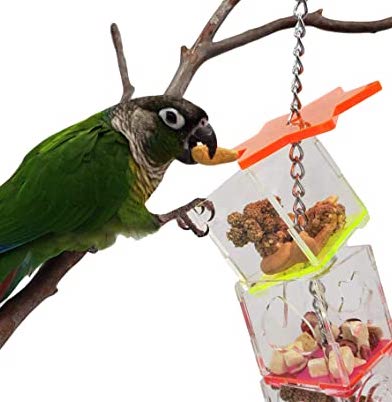Enrichment for Exotic Companion Pets
Enrichment is a continuously growing and evolving concept in animal care which centers around the idea of keeping captive animals stimulated in their environments by allowing them to engage in as many natural behaviors as possible and giving options on how to interact with their environment (essentially giving them choices). Enrichment is widely utilized in zoos and most commonly with large mammals; however, many other species including birds, reptiles, and small mammals are often overlooked. Enrichment and mental stimulation are essential to providing optimal husbandry to any animal kept as a pet. This can be utilized in many ways that are often simple to implement and provide wonderful bonding opportunities for you and your companion, scaled, feathered, and furred alike!
There are two primary types of enrichment for animals:
- Environmental Enrichment – give them something to explore in their environment
- Enrichment Activities – give them a challenge or make them work for rewards
Enrichment for Birds
Birds are extremely intelligent animals and greatly benefit from mental and environmental enrichment and stimulation. A busy bird is a happy bird! Providing opportunities that allow a bird to forage for food instead of getting food from a bowl allows them to engage in natural behavior (foraging) while also encouraging movement and exercise and thus a decreased incidence of obesity and boredom. Placing food in various boxes, on a kabob hanging from the cage, or even in a toilet paper roll can encourage your feathered friend to be more independent and obtain their own meal. Keeping various different toys for the enclosure and switching them out routinely (type of toy, color, location of toy, etc.) can be enjoyable for many birds. Even junk mail and boxes that can be shredded offer activity time. When possible, obtaining another bird (of the same sex to prevent breeding) can also encourage many natural behaviors and provide stimulation. Proper husbandry and enrichment can greatly reduce behavioral disorders commonly seen in birds. 
Note: When considering obtaining another bird, please consult with a veterinarian on best steps for making the introduction and keeping both birds healthy and safe! Should the birds not bond or live together, even having another bird in the same room is beneficial.
Enrichment for Small Mammals
Implementing enrichment for small mammals can be as simple or as elaborate as you wish! Simple techniques include increasing foraging behaviors with a small number of veterinary approved “treats” (species dependent) scattered or hidden around an enclosure to encourage an individual’s foraging skills. Creating additional space for animals to explore 1-2 hours per day that routinely chances (such as mini obstacle courses under supervision) is an excellent way to break up the monotony in a day. Many small mammals LOVE toys as well! Oxbow Animal Health is an example of one company that specializes in toys specifically designed to enrich an animal’s captive life. For more species specific ideas, your veterinarian is a good resource.
Enrichment for Reptiles and Amphibians
Reptiles and amphibians are unfortunately the most commonly neglected species when it comes to environmental enrichment. Fortunately, there are very simple ways to remedy this and provide excellent stimulation. Puzzle feeders designed for dogs and cats are excellent to utilize for foraging behaviors, especially in snakes. Place a frozen, warm-thawed pinky or fuzzy (size dependent per individual snake) in a puzzle feeder encourages the snake or reptile to interact with a new environment and “hunt” their food. Many reptiles are intelligent on such a level that they can be target trained. Individuals that are trained in such a manner are often easier to handle in the veterinary setting as well, as they will know that a treat is a reward for the desired behavior. Small changes to a reptile enclosure with the addition of a branch, plant, or object for the animal to explore can be thoroughly enriching. Consider making these changes as frequently as every other day to simulate the animal being in a “new” environment. Additionally, when considering an animal’s enclosure, it is extremely important to know the animals natural habitat. For example, having a desert species that rarely encounters water be given a small water bath to interact with for a short time period can be enriching. Caution should be taken not to provide too much time so the animal doesn't soak in the water too long. There are many wonderful online and social media groups (https://www.reptelligence.com) or (https://www.facebook.com/groups/reptileenrichmentandtraining) that provide ideas on how to create enriching experiences for a wide variety of reptile species. Please use caution when utilizing these resources for medical advice, as it is impossible to verify everything found on these sources. 
Enrichment is an extremely important aspect of all captive animal care and husbandry. Thought should be given frequently to how you can provide the best, most enriching life for the animal you choose to keep as a companion. Be creative, crafty, and always safe, but explore options for enriching your pets life! When in doubt, ask your veterinarian.



